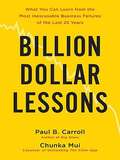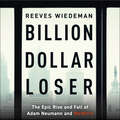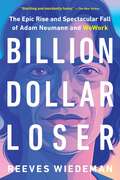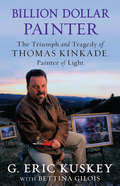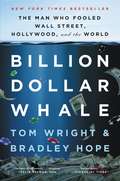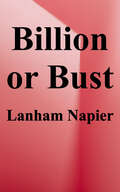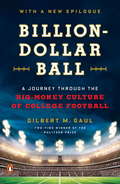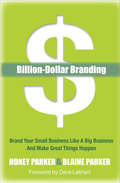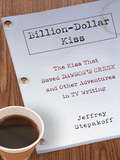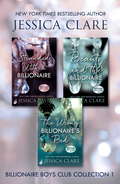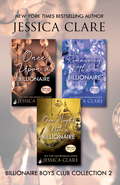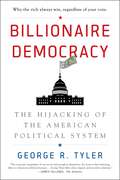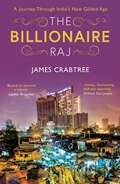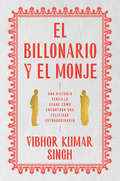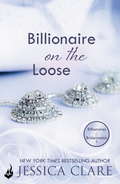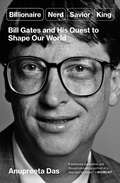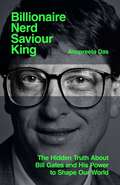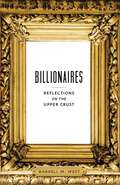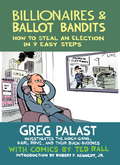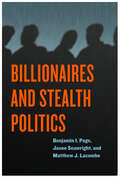- Table View
- List View
Billion Dollar Lessons
by Chunka Mui Paul B. Carroll"This book is your chance to learn from others' mistakes."-- Entrepreneur In the 1960s, IBM CEO Tom Watson called an executive into his office after his venture lost $10 million. The man assumed he was being fired. Watson told him, "Fired? Hell, I spent $10 million educating you. I just want to be sure you learned the right lessons." There are thousands of books about successful companies but virtually none about the lessons to be learned from those that crash and burn. Now Paul Carroll and Chunka Mui draw on research into more than 750 flameouts to reveal the seven biggest reasons for business failure.
Billion Dollar Loser: A Sunday Times Book of the Year
by Reeves WiedemanThe inside story of the rise and fall of WeWork, showing how the excesses of its founder shaped a corporate culture unlike any otherChristened a potential savior of Silicon Valley's startup culture, Adam Neumann was set to take WeWork, his office share company disrupting the commercial real estate market, public, cash out on the company's 47 billion dollar valuation, and break the string of major startups unable to deliver to shareholders. But as employees knew, and investors soon found out, WeWork's capital was built on promises that the company was more than a real estate purveyor, that in fact it was a transformational technology company.Veteran journalist Reeves Weideman dives deep into WeWork and it CEO's astronomical rise, from the marijuana and tequila-filled board rooms to cult-like company summer camps and consciousness-raising with Anthony Kiedis. Billion Dollar Loser is a character-driven business narrative that captures, through the fascinating psyche of a billionaire founder and his wife and co-founder, the slippery state of global capitalism.(P) 2020 Hachette Audio
Billion Dollar Loser: The Epic Rise and Fall of WeWork
by Reeves Wiedeman**The Sunday Times Best Business Book of the Year 2020**'A satisfying ticktock of the company's rapid rise and crash, culminating in its disastrous I.P.O. in 2019 and Neumann's ouster.' New York Times'This absorbing book exposes the sheer madness of WeWork: not just its founder Adam Neumann's extreme hubris, but why so many wiser minds bought into the fairytale.' Sunday TimesThe inside story of the rise and fall of WeWork, showing how the excesses of its founder shaped a corporate culture unlike any other.__________In its earliest days, WeWork promised the impossible: to make the workplace cool.Adam Neumann, an immigrant determined to make his fortune in the United States, landed on the idea of repurposing surplus New York office space for the burgeoning freelance class. Over the course of ten years, WeWork attracted billions of dollars from some of the most sought-after investors in the world, while spending it to build a global real estate empire.Based on more than two hundred interviews, Billion Dollar Loser chronicles the breakneck speed at which WeWork's CEO built and grew his company. Culminating in a day-by-day account of the five weeks leading up to WeWork's botched IPO and Neumann's dramatic ouster, Reeves Wiedeman exposes the story of the company's desperate attempt to secure the funding it needed in the final moments of a decade defined by excess.With incredible access and piercing insight into the company, Billion Dollar Loser tells the full, inside story of WeWork and its CEO Adam Neumann who together came to represent the most audacious, and improbable, rise and fall in business.__________A Sunday Times Best Business Book of the YearFortune Best Book of the YearNew York Times' Books to Watch For in OctoberWIRED Books to Read This FallBloomberg's Nonfiction Title to Know this FallNewsweek's Must Read Fall NonfictionPublishers Weekly Top Ten for Business & EconomicsInsideHook's Best Books for OctoberLike John Carreyrou's Bad Blood and Mike Isaac's Super Pumped before it, Billion Dollar Loser traces the turmoil at a startup driven by a charismatic, arrogant founder.'A frisky dissection of how a rickety real-estate leasing company tricked the world into seeing it as an immensely valuable, society-shifting tech unicorn.' WIRED
Billion Dollar Loser: The Epic Rise and Spectacular Fall of Adam Neumann and WeWork
by Reeves Wiedeman&“Vivid, carefully reported drama that readers will gulp down as if it were a fast-paced novel&” (Ken Auletta) ꟷ the inside story of WeWork and its CEO, Adam Neumann, which tells the remarkable saga of one of the most audacious, and improbable, rises and falls in American business history In its earliest days, WeWork promised the impossible: to make the American work place cool. Adam Neumann, an immigrant determined to make his fortune in the United States, landed on the idea of repurposing surplus New York office space for the burgeoning freelance class. Over the course of ten years, WeWork attracted billions of dollars from some of the most sought-after investors in the world, while spending it to build a global real estate empire that he insisted was much more than that: an organization that aspired to nothing less than "elevating the world's consciousness." Moving between New York real estate, Silicon Valley venture capital, and the very specific force field of spirituality and ambition erected by Adam Neumann himself, Billion Dollar Loser lays bare the internal drama inside WeWork. Based on more than two hundred interviews, this book chronicles the breakneck speed at which WeWork&’s CEO built and grew his company along with Neumann&’s relationship to a world of investors, including Masayoshi Son of Softbank, who fueled its chaotic expansion into everything from apartment buildings to elementary schools. Culminating in a day-by-day account of the five weeks leading up to WeWork&’s botched IPO and Neumann&’s dramatic ouster, Wiedeman exposes the story of the company&’s desperate attempt to secure the funding it needed in the final moments of a decade defined by excess. Billion Dollar Loser is the first book to indelibly capture the highly leveraged, all-blue-sky world of American business in President Trump&’s first term, and also offers a sober reckoning with its fallout as a new era begins.
Billion Dollar Painter: The Triumph and Tragedy of Thomas Kinkade, Painter of Light
by Bettina Gilois G. Eric KuskeyThe unbelievable true story of artist Thomas Kinkade, self-described "Painter of Light,” and the dramatic rise -and fall-of his billion-dollar gallery and licensing business. He was just one man, but Thomas Kinkade ultimately made more money from his art than every other artist in the history of the world combined. His sentimental paintings of babbling brooks, rural churches surrounded by brilliant fall foliage, and idyllic countryside cottages were so popular in the 1990s that one out of every twenty homes in America owned one of his prints. With the help of two partners-a former vacuum-cleaner salesman and an ambitious junior accountant who fancied himself a businessman-Kinkade turned his art into a billion-dollar gallery and licensing business that traded on the NYSE before it collapsed in 2006 amid fraud accusations. One part a fascinating business story about the rise, and demise, of a financial empire born out of divine inspiration, one part a dramatic biography, Billion Dollar Painter is the account of three nobodies who made it big. One of them was a man who, despite being a devout Christian who believed his artwork was a spiritual force that could cure the sick and comfort the poor in spirit, could not save his art empire, or himself. Eric Kuskey, former colleague of Thomas Kinkade's and close friend until the artist’s death in 2012, tells Kinkade’s story for the first time-from his art’s humble beginnings on a sidewalk in Carmel, California, to his five-house compound in Monte Sereno. It’s a tale of addiction and grief, of losing control, and ultimately, of the price of our dreams.
Billion Dollar Whale: The Man Who Fooled Wall Street, Hollywood, and the World
by Tom Wright Bradley HopeThe definitive inside account of the "extraordinary" (Financial Times) 1MDB scandal, "a true life thriller" (Ben Mezrich) about a "modern Gatsby" who managed to swindle over $5 billion with the aid of Goldman Sachs and others--a "must read" (Booklist) "epic tale" (Publishers Weekly) that exposes the secret nexus of elite wealth, banking, Hollywood, and politics from two award-winning Wall Street Journal reporters. <P><P>In 2009, with the dust yet to settle on the financial crisis, a baby-faced, seemingly mild-mannered Wharton grad began setting in motion a fraud of unprecedented gall and magnitude--one that would come to symbolize the next great threat to the global financial system. His name is Jho Low, a man whose behavior was so preposterous he might seem made up. <P><P> An epic true-tale of hubris and greed, Billion Dollar Whale reveals how this young social climber pulled off one of the biggest heists in history--right under the nose of the global financial industry. <P><P>Federal agents who helped unravel Bernie Madoff's Ponzi scheme say the 1MDB affair will become the textbook case of financial fraud in the modern age--and its fallout is already being credited for taking down the prime minister of Malaysia. With his yacht and private jet reportedly seized by authorities and facing money-laundering charges in Malaysia, an Interpol red notice, and an ongoing U.S. Department of Justice Investigation, Low has become an international fugitive. <P><P>For readers of Liar's Poker, Den of Thieves, and Bad Blood, Billion Dollar Whale will become a classic, harrowing parable about finance run amok. <P><b>A New York Times Bestseller</b>
Billion or Bust!: Growing a Tech Company in Texas
by Lanham NapierAs president and then CEO of cloud provider Rackspace, Lanham Napier grew the company from $5 million to over $1 billion in revenues and $5 billion in market value while creating thousands of jobs. Under his leadership, especially growing its trademarked, high-quality customer service, Fanatical Support, Rackspace gained thousands of customers and industry dominance. <p><p>A lifelong Texan, Lanham grew the company in his home state, overseeing the development of phenomenal new headquarters (a converted mall) in San Antonio and leading the company's IPO. Further, he obsessed over how to increase employee engagement, and he exuberantly succeeded in his goal. But, when Microsoft, Amazon, and Google entered the industry in force, everything changed . . . including Lanham's relationship with Rackspace executives and the company's board of directors. <p><p>Lanham believed he had three options for leading the Rackspace response to the intense competition. But in fact, the board showed him that there was a fourth option he had never even considered. <p><p>Lanham Napier is an entrepreneur, innovator, investor, and Texan. He and his team at his investment fund, BuildGroup, believe in providing smart capital to passionate entrepreneurs who want to build companies for the long haul. Lanham developed his ideas about risk capital as a boy seeing family members and others who found themselves unable to gain access to risk capital (or, in many cases) any capital. He then deepened those ideas through his work as CEO raising money for and leading the IPO of Rackspace. Lanham grew up a proud Texan, enamored with the state climate, history, diversity, friendliness, and traditions. Also in his adolescence, Lanham developed a driving desire to improve the world through creating jobs for people. In special sections of the book, Lanham discuss the benefits and drawbacks of growing the company outside Silicon Valley and major tech centers.
Billion-Dollar Ball
by Gilbert M. Gaul"A penetrating examination of how the elite college football programs have become 'a giant entertainment businesses that happened to do a little education on the side.'"--Mark Kram, The New York TimesTwo-time Pulitzer-Prize-winning journalist Gilbert M. Gaul offers a riveting and sometimes shocking look inside the money culture of college football and how it has come to dominate a surprising number of colleges and universities. Over the past decade college football has not only doubled in size, but its elite programs have become a $2.5-billion-a-year entertainment business, with lavishly paid coaches, lucrative television deals, and corporate sponsors eager to slap their logos on everything from scoreboards to footballs and uniforms. Profit margins among the top football schools range from 60% to 75%--results that dwarf those of such high-profile companies as Apple, Facebook and Microsoft--yet thanks to the support of their football-mad representatives in Congress, teams aren't required to pay taxes. In most cases, those windfalls are not passed on to the universities themselves, but flow directly back into their athletic departments.College presidents have been unwilling or powerless to stop a system that has spawned a wildly profligate infrastructure of coaches, trainers, marketing gurus, and a growing cadre of bureaucrats whose sole purpose is to ensure that players remain academically eligible to play. From the University of Oregon's lavish $42 million academic center for athletes to Alabama coach Nick Saban's $7 million paycheck--ten times what the school pays its president, and 70 times what a full-time professor there earns--Gaul examines in depth the extraordinary financial model that supports college football and the effect it has had not only on other athletic programs but on academic ones as well. What are the consequences when college football coaches are the highest paid public employees in over half the states in an economically troubled country, or when football players at some schools receive ten times the amount of scholarship awards that academically gifted students do? Billion-Dollar Ball considers these and many other issues in a compelling account of how an astonishingly wealthy sports franchise has begun to reframe campus values and distort the fundamental academic mission of our universities.From the Hardcover edition.
Billion-Dollar Ball: A Journey Through the Big-Money Culture of College Football
by Gilbert M. Gaul* A Boston Globe Best Book of 2015 * <P><P>"A penetrating examination of how the elite college football programs have become 'giant entertainment businesses that happened to do a little education on the side.'"--Mark Kram, The New York Times <P><P>Two-time Pulitzer-Prize-winning journalist Gilbert M. Gaul offers a riveting and sometimes shocking look inside the money culture of college football and how it has come to dominate a surprising number of colleges and universities. <P><P>Over the past decade college football has not only doubled in size, but its elite programs have become a $2.5-billion-a-year entertainment business, with lavishly paid coaches, lucrative television deals, and corporate sponsors eager to slap their logos on everything from scoreboards to footballs and uniforms. <P><P>Profit margins among the top football schools range from 60% to 75%--results that dwarf those of such high-profile companies as Apple, Facebook, and Microsoft--yet thanks to the support of their football-mad representatives in Congress, teams aren't required to pay taxes. <P><P>In most cases, those windfalls are not passed on to the universities themselves, but flow directly back into their athletic departments. <P><P>College presidents have been unwilling or powerless to stop a system that has spawned a wildly profligate infrastructure of coaches, trainers, marketing gurus, and a growing cadre of bureaucrats whose sole purpose is to ensure that players remain academically eligible to play. <P><P>From the University of Oregon's lavish $42 million academic center for athletes to Alabama coach Nick Saban's $7 million paycheck--ten times what the school pays its president, and 70 times what a full-time professor there earns--Gaul examines in depth the extraordinary financial model that supports college football and the effect it has had not only on other athletic programs but on academic ones as well. <P><P>What are the consequences when college football coaches are the highest paid public employees in over half the states in an economically troubled country, or when football players at some schools receive ten times the amount of scholarship awards that academically gifted students do? <P><P>Billion-Dollar Ball considers these and many other issues in a compelling account of how an astonishingly wealthy sports franchise has begun to reframe campus values and distort the fundamental academic mission of our universities.From the Hardcover edition.
Billion-Dollar Branding: Brand Your Small Business Like a Big Business and Make Great Things Happen
by Honey Parker Blaine ParkerTwo advertising veterans explain the myths about branding—and how even the smallest businesses can benefit by defining themselves to their customers. Branding may be the single most misunderstood concept in marketing. It&’s not only for big businesses with big bucks. It&’s not about a logo, a color, a font, or a type of advertising. Branding is defining a company&’s image in such a way that the customer is left with a single feeling about that business and what they do. Branding is about finding a business&’s juicy center. Even small businesses on shoestring budgets and sole practitioners can learn the principles of good branding—an effort that encompasses not just messaging, but multiple day-to-day decisions that shape and build your customers&’ perceptions and emotions. With numerous real-life examples and the expertise that comes only from experience, this book guides you to a new way of thinking about your business, and the kind of wisdom that no amount of money can buy.
Billion-Dollar Fish: The Untold Story of Alaska Pollock
by Kevin M. BaileyAlaska pollock is everywhere. If you’re eating fish but you don’t know what kind it is, it’s almost certainly pollock. Prized for its generic fish taste, pollock masquerades as crab meat in california rolls and seafood salads, and it feeds millions as fish sticks in school cafeterias and Filet-O-Fish sandwiches at McDonald’s. That ubiquity has made pollock the most lucrative fish harvest in America—the fishery in the United States alone has an annual value of over one billion dollars. But even as the money rolls in, pollock is in trouble: in the last few years, the pollock population has declined by more than half, and some scientists are predicting the fishery’s eventual collapse. In Billion-Dollar Fish, Kevin M. Bailey combines his years of firsthand pollock research with a remarkable talent for storytelling to offer the first natural history of Alaska pollock. Crucial to understanding the pollock fishery, he shows, is recognizing what aspects of its natural history make pollock so very desirable to fish, while at the same time making it resilient, yet highly vulnerable to overfishing. Bailey delves into the science, politics, and economics surrounding Alaska pollock in the Bering Sea, detailing the development of the fishery, the various political machinations that have led to its current management, and, perhaps most important, its impending demise. He approaches his subject from multiple angles, bringing in the perspectives of fishermen, politicians, environmentalists, and biologists, and drawing on revealing interviews with players who range from Greenpeace activists to fishing industry lawyers. Seamlessly weaving the biology and ecology of pollock with the history and politics of the fishery, as well as Bailey’s own often raucous tales about life at sea, Billion-Dollar Fish is a book for every person interested in the troubled relationship between fish and humans, from the depths of the sea to the dinner plate.
Billion-Dollar Kiss
by Jeffrey StepakoffNow in paperback, the riveting behind-the-scenes look at how television shows are really created, from a successful writer-producerWhen Jeffrey Stepakoff was graduating with an MFA in playwriting, he imagined a life in theater. Writing for TV didn't even cross his mind. But he ended up in L. A. in the late eighties, when television writers were experiencing a gold rush. After the billion-dollar syndication of Seinfeld, the mania for scripted entertainment made the TV writer a hot commodity. Weaving his personal narrative with a history of television, Stepakoff shows what it's like to have a story idea one week and then have it seen by millions a week later. He also takes us inside the industry to explore the problems of media consolidation, interference by executives, lack of diversity, and what reality television is doing to quality scripted television.
Billionaire Boys Club Collection 1: Stranded With A Billionaire, Beauty And The Billionaire, The Wrong Billionaire's Bed (Billionaire Boys Club)
by Jessica ClareIndulge in the Billionaire Boys Club Collection, featuring Books 1, 2 and 3 in the series. Fans of J.S. Scott, Louise Bay and Melody Anne - prepare to be dazzled by Jessica Clare's Billionaire Boys Club, a secret society of six incredibly wealthy men who have vowed success in business - at any cost. But success when it comes to love is a different matter...In STRANDED WITH A BILLIONAIRE, Billionaire Logan Hawkings needs a vacation. He's had a rough time after the death of his father and the betrayal of his fiancée. But with a visit to a recent business acquisition - a private island resort in the Bahamas - he has a chance to mend his broken heart. Bronte Dawson, a waitress from the Midwest, is stranded with the hotel's domineering yet sexy manager Logan. What's the harm in a little fling when it's just the two of them, alone in paradise? But she soon discovers there's more to Logan than he's told her...a billion times more. Now, Bronte's caught in a whirlwind affair with one of the world's most powerful men. But can their love endure their differences or will it all just blow over?In BEAUTY AND THE BILLIONAIRE, real-estate tycoon Hunter Buchanan has a dark past that's left him scarred and living as a recluse on his family's palatial estate. Hunter is ready to give up on love - until he spots an enigmatic red-haired beauty and comes up with an elaborate scheme to meet her. Gretchen Petty is in need of a paycheck - and a change. So when a job opportunity in an upstate New York mansion pops up she accepts. And while she can overlook the oddities of her new job, she can't ignore her new boss's delectable body - or his barely leashed temper. Hunter's afraid his plan might be unraveling before it's truly begun, but Gretchen is about to show him that life can be full of surprises...In THE WRONG BILLIONAIRE'S BED, Audrey Petty's always been the responsible one. The good twin. She'd be the perfect girlfriend for her childhood crush, billionaire Cade Archer...except that she's pretty sure she's not even on his radar. But when fate decrees that Audrey spend time with Cade at his remote cabin retreat, it's a dream come true... Until she meets her worst nightmare. Billionaire playboy Reese Durham is used to seducing women to get what he wants. But when stiff, too-proper Audrey arrives at his buddy's mountain lodge it's clear that Audrey's in love with Cade...and it's clear to Reese that blackmailing Audrey with this information can get her to agree to just about anything. Like furtive kisses, or a secret rendezvous in the woods. Audrey may think she knows what she wants, but Reese is determined to show her what she needs...Want more irresistible romance? Look for the rest of Billionaire Boys Club titles, as well as the sizzling spinoff series, Billionaires and Bridesmaids, starting with The Billionaire And The Virgin.
Billionaire Boys Club Collection 2: Once Upon A Billionaire, Romancing The Billionaire, One Night With A Billionaire (Billionaire Boys Club)
by Jessica ClareIndulge in the Billionaire Boys Club Collection, featuring Books 4, 5 and 6 in the series. Fans of J.S. Scott, Louise Bay and Melody Anne - prepare to be dazzled by Jessica Clare's Billionaire Boys Club, a secret society of six incredibly wealthy men who have vowed success in business - at any cost. But success when it comes to love is a different matter...In ONCE UPON A BILLIONAIRE, when scholarly billionaire Griffin Verdi must return to his country for the wedding of the century, he needs a good assistant at his side. Unfortunately for him, he's stuck with Maylee Meriweather, a pretty, charming, and thoroughly unsuitable woman who doesn't know a thing about high society...but she sure can kiss. But will Griffin be able to get past Maylee's lack of polish? And will Maylee be able to fall for a man that looks down on everything she's come from?In ROMANCING THE BILLIONAIRE, Jonathan Lyons, playboy, billionaire and adventurer, lives life on the edge. When he hears that his mentor, Dr Phineas DeWitt, had a secret journal that leads to a legendary artifact, Jonathan takes action. It stirs his blood, but it comes with a heady challenge: DeWitt's daughter Violet. She has what Jonathan needs. And she's not giving it up it to the man who broke her heart. Violet is Jonathan's weakness - he's still in love despite their volatile breakup a decade ago. But Violet's memories have a sharper edge. She's never forgiven him for abandoning her. Or so she thought. When Jonathan's attentions turn seductive, she's in danger of falling for him all over again. And she can't help but wonder...does he really want her, or just what she's hiding?In ONE NIGHT WITH A BILLIONAIRE, Kylie may be a makeup artist to the stars, but she knows what it feels like to be overshadowed. Especially by her famous boss, the pop star Daphne. That's why she's stunned - and delighted - when one night at a party, she attracts the attention of a gorgeous stranger. But when Daphne decides she wants the handsome billionaire for herself, Cade Archer is suddenly off-limits for Kylie... Cade has known Daphne for years, and always wondered if she might be the right woman for him - even though she never gave him the time of day. But one sizzling night with Kylie has changed everything. So why is she suddenly avoiding him? Fortunately Cade is determined to get what he wants, and he'll do anything to show Kylie she can get everything she wants too...Want more irresistible romance? Look for the rest of Billionaire Boys Club titles, as well as the sizzling spinoff series, Billionaires and Bridesmaids, starting with The Billionaire And The Virgin.
Billionaire Democracy: The Hijacking of the American Political System
by George TylerThis isn&’t your America. No matter who the president is. We&’re told that when we vote, when we elect representatives, we&’re gaining a voice in government and the policies it implements. But if that&’s true, why don&’t American politics actually translate our preferences into higher-living standards for the majority of us? The answer is that, in America, the wealthy few have built a system that works in their favor, while maintaining the illusion of democracy. The reality is that the quality of democracy in the United States is lower than in any other rich democracy, on a par with nations such as Brazil or Turkey. In the US, voters have little influence on eventual policy outcomes engineered by lawmakers. Political scientists call it the income bias and attribute it to the power of wealthy donors who favor wage suppression and cuts to important government programs such as public education and consumer protection. It causes American lawmakers to compete to satisfy preferences of donors from the top one percent instead of the middle class. It&’s also why our economy has been misfiring for most Americans for a generation, wages stagnating and opportunity dwindling. The election of Donald Trump shocked the world, but for many Americans, it came as a stark reflection of mounting frustrations with our current system and anger at the status quo. We need to find a way to fix the way our government serves us. The only realistic pathway to improve middle-class economics is for Congress and the Supreme Court to raise the quality of American democracy. In Billionaire Democracy: The Hijacking of the American Political System, economist George R. Tyler lays out the fundamental problems plaguing our democracy. He explains how the American democratic system is rigged and how it has eroded the middle class, providing an unflinching and honest comparison of the US government to peer democracies abroad. He also breaks down where we fall short and how other rich democracies avoid the income bias created by the overwhelming role of money in US politics. Finally, Tyler outlines practical campaign finance reforms we can adopt when we finally focus on improving the political responsiveness of our government. It&’s time for the people of this nation to demand a government that properly serves us, the American people.
Billionaire Raj: SHORTLISTED FOR THE FT & MCKINSEY BUSINESS BOOK OF THE YEAR AWARD 2018
by James CrabtreeSHORTLISTED FOR THE FT & MCKINSEY BUSINESS BOOK OF THE YEAR AWARD 2018 A Financial Times Book of the Year and an Amazon Top 100 Book of the Year India&’s explosive rise has driven inequality to new extremes, with millions trapped in slums as billionaires spend lavishly and dodge taxes. Controversial prime minister Narendra Modi promised &‘to break the grip&’ of the Bollygarchs, but many tycoons continue to thrive amidst the scandals, exerting huge influence over business and politics. But who are these titans of politics and industry shaping India through this period of breakneck change? And what kind of superpower are they creating? A vivid portrait of a deeply divided nation, The Billionaire Raj makes clear that India&’s destiny – prosperous democratic giant or corrupt authoritarian regime – is something that should concern us all.
Billionaire Wilderness: The Ultra-Wealthy and the Remaking of the American West (Princeton Studies in Cultural Sociology #83)
by Justin FarrellA revealing look at the intersection of wealth, philanthropy, and conservationBillionaire Wilderness takes you inside the exclusive world of the ultra-wealthy, showing how today's richest people are using the natural environment to solve the existential dilemmas they face. Justin Farrell spent five years in Teton County, Wyoming, the richest county in the United States, and a community where income inequality is the worst in the nation. He conducted hundreds of in-depth interviews, gaining unprecedented access to tech CEOs, Wall Street financiers, oil magnates, and other prominent figures in business and politics. He also talked with the rural poor who live among the ultra-wealthy and often work for them. The result is a penetrating account of the far-reaching consequences of the massive accrual of wealth, and an eye-opening and sometimes troubling portrait of a changing American West where romanticizing rural poverty and conserving nature can be lucrative—socially as well as financially.Weaving unforgettable storytelling with thought-provoking analysis, Billionaire Wilderness reveals how the ultra-wealthy are buying up the land and leveraging one of the most pristine ecosystems in the world to climb even higher on the socioeconomic ladder. The affluent of Teton County are people burdened by stigmas, guilt, and status anxiety—and they appropriate nature and rural people to create more virtuous and deserving versions of themselves. Incisive and compelling, Billionaire Wilderness reveals the hidden connections between wealth concentration and the environment, two of the most pressing and contentious issues of our time.
Billionaire and the Monk, The \ El Billonario y el Monje (Spanish edition): Una historia sencilla sobre cómo encontrar una felicidad extraordiaria
by Vibhor Kumar SinghLa mayor sabiduría se encuentra a menudo en el conocimiento más simple.¿Qué pasa si aprende que todo lo que le han enseñado sobre la felicidad es falso? ¿Qué pasa si te das cuenta de que la felicidad no es una meta y, por lo tanto, no se puede lograr? ¿Qué pasa si descubre que es el camino ordinario el que conduce a un tesoro extraordinario?Esta es una historia sobre cómo dos hombres de diferentes ámbitos de la vida aprenden que no se requieren ropas de honor ni la renuncia total a la vida mundana para disfrutar del ser humano más fundamental: la felicidad.Es una historia sobre la comprensión de que la felicidad no es un enigma filosófico, sino un estado mental alcanzable y cómo uno puede apreciar las mayores alegrías a través de los actos más simples y pequeños de la vida diaria.Permítanos simplificar la felicidad y encontrar la respuesta extraordinaria a la pregunta ordinaria: ¿eres feliz?
Billionaire on the Loose: Billionaires and Bridesmaids 5 (Billionaires and Bridesmaids #5)
by Jessica ClareEnter the illustrious world of Jessica Clare's billionaires and bridesmaids. Fans of J.S. Scott, Louise Bay and Melody Anne will addicted to this sizzling, coveted New York Times bestseller. You met the six bachelors of the Billionaire Boys Club... Now it's time to pair up some filthy-rich billionaires with lucky ladies in waiting and enjoy the spoils... Taylor is a genius when it comes to computers, but understanding the opposite sex is beyond her. Because she always fumbles her flirtations, she needs help in finding her Prince Charming. So when her friend, Gretchen, sets her up as a tour guide for a new guy in town, she says yes despite her misgivings.She just doesn't expect Mr. Charming to actually be royalty...A faction in his country wants him to be king, but Loch has no intention of taking the crown. To keep from being named as the next successor, he hatches a scheme to marry a totally unacceptable American woman. Quirky Taylor seems like the perfect person for the job, until Loch realizes he likes more about her than her ability to keep him off the throne.When Loch's secret schemes come out, his chance of happiness with Taylor are blown - unless he can find a way to get the nerdy object of his affection to believe she's truly the queen of his heart... Includes a teaser for The Billionaire's Favourite Mistake!After more dazzling romance? Look out for the rest of the Billionaire and Bridesmaids series starting with The Billionaire And The Virgin or take a spin with the steamy Billionaire Boys Club starting with Stranded With A Billionaire.
Billionaire, Nerd, Savior, King: Bill Gates and His Quest to Shape Our World
by Anupreeta DasFrom the finance editor of The New York Times, an examination of Bill Gates—one of the most powerful, fascinating, and contradictory figures of the past four decades—and an eye-opening exploration of our national fixation on billionaires.Few billionaires have been in the public eye for as long, and in as many guises, as Bill Gates. At first heralded as a tech visionary, the Microsoft cofounder next morphed into a ruthless capitalist, only to change yet again when he fashioned himself into a global do-gooder. Along the way, Gates forever influenced how we think about tech founders, as the products they make and the ideas they sell continue to dominate our lives. Through the Bill & Melinda Gates Foundation, he also set a new standard for high-profile, billionaire philanthropy. But there is more to Gates&’s story, and here, Das&’s revelatory reporting shows us that billionaires have secrets and philanthropy can have a dark side. Drawing upon hundreds of interviews with current and former employees of the Gates Foundation, Microsoft, academics, nonprofits, and those with insight into the Gates universe, Das delves into Gates&’s relationships with Warren Buffett, Jeffrey Epstein, Melinda French Gates, and others, to uncover the truths behind the public persona. In telling Gates&’s story, Das also provides a new way to think about how billionaires wield their power, manipulate their image, and pursue philanthropy to become heroes, repair damaged reputations, and direct policy to achieve their preferred outcomes. Insightful, illuminating, and timely, Billionaire, Nerd, Savior, King is an important story of money and government, wealth and power, and media and image, and the ways in which the world&’s richest people hold us in their thrall.
Billionaire, Nerd, Saviour, King: The Hidden Truth About Bill Gates and His Power to Shape Our World
by Anupreeta DasBill Gates is one of the most powerful figures of the past four decades. But the world-famous public image he has so carefully crafted is not the whole truth. In this explosive new book, Anupreeta Das (finance editor of the New York Times) takes you behind the façade. From his early years, when he was a divisive figure in the burgeoning tech industry, we see the Microsoft co-founder morph into a ruthless capitalist, only to change yet again when he fashions himself into a global do-gooder. But as Das&’s revelatory reporting shows us: billionaires have secrets and philanthropy can have a dark side. Drawing upon hundreds of interviews with current and former employees of the Gates Foundation, Microsoft, and those with insight into the Gates universe, Das delves into Gates&’s relationships with Warren Buffett, Jeffrey Epstein, Melinda French Gates and others to uncover the man behind the persona. In telling Gates&’s story, Das also provides a new way to think about how billionaires wield their influence, manipulate their image and pursue philanthropy to achieve their own ends.Billionaire, Nerd, Saviour, King is a gripping story of wealth, power and reputation; it will open your eyes to the ways in which the world&’s richest people hold us in their thrall.
Billionaires
by Darrell M. WestMeet the Billionaires: the 1,645 men and women who control a massive share of global assets worth $6.5 trillion. Darrell West reveals what the other 99.99998% of us need to know.With rich anecdotes and personal narratives, West goes inside the world of the ultra wealthy. Meet U.S. billionaires such as Sheldon Adelson, Michael Bloomberg, David and Charles Koch, George Soros, Tom Steyer, and Donald Trump--as well as international billionaires from around the globe.The growing political engagement of this small supra-wealthy group raises important questions about influence, transparency, and government performance, and West lays bare the wealthification of politics, including:* How billionaires can block appointments and legislation they don't like* Why the supra-wealthy moved into policy advocacy and referenda at the state level* Why billionaires run for office in more than a dozen countries around the worldraine. From oligarchs in Russia and Eastern Europe to princelings in China, tycoons raise important questions about political influence, transparency, accountability, and government performance. This book argues that countries need policies that promote better transparency, governance, and opportunity.
Billionaires
by Darrell M. WestMeet the Billionaires: the 1,645 men and women who control a massive share of global assets worth $6.5 trillion. Darrell West reveals what the other 99.99998% of us need to know.With rich anecdotes and personal narratives, West goes inside the world of the ultra wealthy. Meet U.S. billionaires such as Sheldon Adelson, Michael Bloomberg, David and Charles Koch, George Soros, Tom Steyer, and Donald Trump-as well as international billionaires from around the globe.The growing political engagement of this small supra-wealthy group raises important questions about influence, transparency, and government performance, and West lays bare the wealthification of politics, including: How billionaires can block appointments and legislation they don't like Why the supra-wealthy moved into policy advocacy and referenda at the state level Why billionaires run for office in more than a dozen countries around the world
Billionaires & Ballot Bandits: How to Steal an Election in 9 Easy Steps
by Greg PalastA close presidential election in November could well come down to contested states or even districts--an election decided by vote theft? It could happen this year. Based on Greg Palast and Robert F. Kennedy, Jr.'s investigative reporting for Rolling Stone and BBC television, Billionaires & Ballot Bandits: How to Steal an Election in 9 Easy Steps might be the most important book published this year--one that could save the election. Billionaires & Ballot Bandits names the filthy-rich sugar-daddies who are super-funding the Super-PACs of both parties--billionaires with nicknames like "The Ice Man," "The Vulture" and, of course, The Brothers Koch. Told with Palast's no-holds-barred, reporter-on-the-beat style, the facts as he lays them out are staggering. What emerges in Billionaires & Ballot Bandits is the never-before-told-story of the epic battle being fought behind the scenes between the old money banking sector that still supports Obama, and the new hedge fund billionaires like Paul Singer who not only support Romney but also are among his key economic advisors. Although it has not been reported, Obama has shown some backbone in standing up to the financial excesses of the men behind Romney. Billionaires & Ballot Bandits exposes the previously unreported details on how operatives plan to use the hundreds of millions in Super-PAC money pouring into this election. We know the money is pouring in, but Palast shows us the convoluted ways the money will be used to suppress your vote.The story of the billionaires and why they want to buy an election is matched with the nine ways they can steal the election. His story of the sophisticated new trickery will pick up on Palast's giant New York Times bestseller, The Best Democracy Money Can Buy.
Billionaires and Stealth Politics
by Benjamin I. Page Jason Seawright Matthew J. LacombeIn 2016, when millions of Americans voted for Donald Trump, many believed his claims that personal wealth would free him from wealthy donors and allow him to “drain the swamp.” But then Trump appointed several billionaires and multimillionaires to high-level positions and pursued billionaire-friendly policies, such as cutting corporate income taxes. Why the change from his fiery campaign rhetoric and promises to the working class? This should not be surprising, argue Benjamin I. Page, Jason Seawright, and Matthew J. Lacombe: As the gap between the wealthiest and the rest of us has widened, the few who hold one billion dollars or more in net worth have begun to play a more and more active part in politics—with serious consequences for democracy in the United States. Page, Seawright, and Lacombe argue that while political contributions offer a window onto billionaires’ influence, especially on economic policy, they do not present a full picture of policy preferences and political actions. That is because on some of the most important issues, including taxation, immigration, and Social Security, billionaires have chosen to engage in “stealth politics.” They try hard to influence public policy, making large contributions to political parties and policy-focused causes, leading policy-advocacy organizations, holding political fundraisers, and bundling others’ contributions—all while rarely talking about public policy to the media. This means that their influence is not only unequal but also largely unaccountable to and unchallengeable by the American people. Stealth politics makes it difficult for ordinary citizens to know what billionaires are doing or mobilize against it. The book closes with remedies citizens can pursue if they wish to make wealthy Americans more politically accountable, such as public financing of political campaigns and easier voting procedures, and notes the broader types of reforms, such as a more progressive income tax system, that would be needed to increase political equality and reinvigorate majoritarian democracy in the United States.
